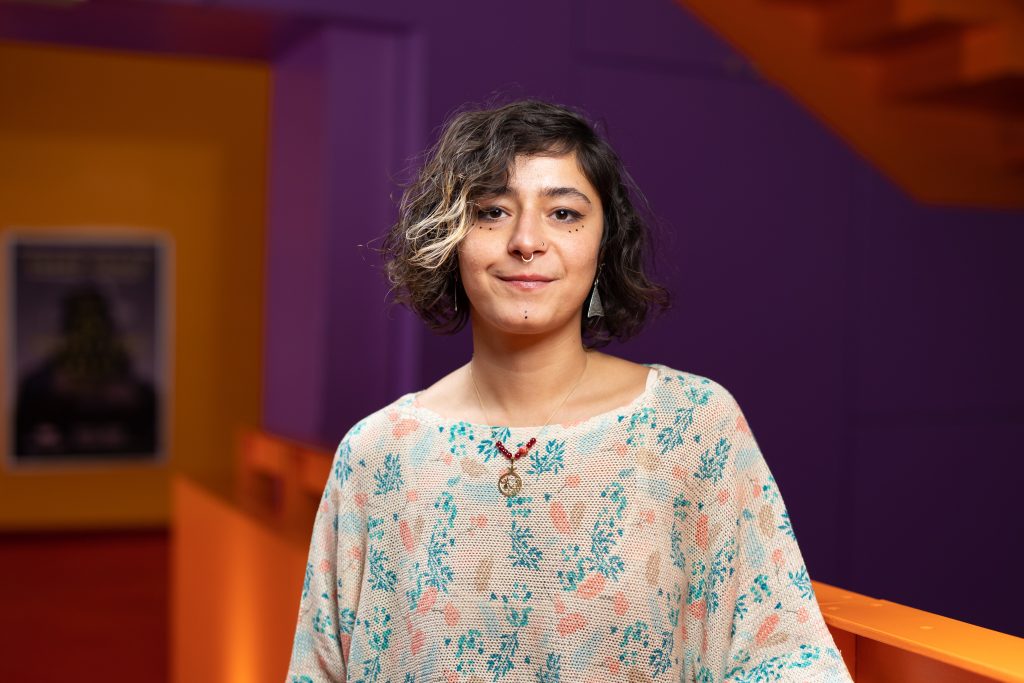As her first solo exhibition, Nikta Mohammadi’s Memory Stone is an enthralling exploration of place and the impermanence of memory.
Prior to Mohammadi’s exhibition drawing to a close on 5th May, The Lowry held a special screening of the film at its event, Memory Sounds.
The feature came complete with a live orchestra, led by composer Babak Mirsalari, who also played the synthesiser and the keyboard.
The evening an eye-opening Q&A session with the creator herself, led by writer and filmmaker Dan Guthrie.
The 20-minute film follows a lone rambler through the empty moors of Calderdale, West Yorkshire.
While on his travels, the unnamed man encounters a strange, otherworldly structure that triggers a sudden release of memories.
These flashbacks are revealed in various places on the moors and along the Bride Stones, a gathering of great boulders which modern lore attributes to be dedicated to the Celtic deity Bride, goddess of the Brigantian people.
Much can be said about the film, whose ambiguity leaves it open to interpretation. But what cannot be denied is the importance of place in the work as a storytelling device.

In an interview with The Lowry, Mohammadi said of the setting: “Something that is very special about the landscape in West Yorkshire is the emptiness that almost feels like a reflective surface.
“So memory stone in a way is an exploration of this vastness and emptiness.”
As viewers we get the sense of the moors as both a dreamscape where pretty much anything goes, and as an alien landscape where barely coherent memories border on becoming reality.
Throughout, the rambler is plagued by literal flashes of other places and experiences that untether him from his current reality and leave him unable to truly connect to any other.

The barren Yorkshire moors, accompanied by bleak, low-hanging clouds and a hair-tugging breeze are the perfect setting for the fragmented events of the film.
At one point we see the man’s silhouette gradually emerging from a heavy mist appearing barely corporeal, a beautiful shot which can be read as a presentation of the man’s displacement, belonging neither to one place or another.
This is likely what Mohammadi intended; the artist’s enduring interest in the migrant experience and the imprints that they create on foreign lands permeates every scene and every interaction.
But if the film itself can be viewed as a series of detailed sketches, appearing definitely there but not quite definite. But the haunting music and the uncanny narration are what fill it with turbulent splashes of colour.
Composer Babak Mirsalari and his orchestra bring the film to life as a meditation on the migrant experience. Western piano tunes collide with ancient Iranian strings of the Gheycheck and the Santoor. The effect should be discordant, and it is; but one gets the sense that this is the point.

The narration is in Farsi and comes from a character from the man’s distant past, but English subtitles allow for viewers unfamiliar with the language to follow along.
There is just enough narration that it doesn’t feel like an intrusion into the visual landscape and the figures the man encounters. Instead, it is expertly woven through as an essential medium of storytelling.
Like the film itself, narration feels fragmentary and somehow distant, as a woman’s voice intones, “We looked at each other and we grew,” and later, “We dreamt of leaving, of breaking, of stretching and reaching the oceans.”
The deliciously strange visuals, the captivating sounds and the poetic narration all seem designed to keep the audience slightly destabilised at all times.

The appearance of the four figures enhance this effect. While one of them is verbal and actively interacts with the rambler, the remaining women are often filmed carrying a large structure reminiscent of that used in Iranian burial rituals.
The connections from the past to the present, from the dusty landscape of Iran to the barren moors of West Yorkshire, and from the current reality to a fractured dreamworld are so discordant and unstable that the film could have been an incoherent mess.
Yet its impressive direction, intriguing story and beautifully unsettling music make for an intriguing and transformative experience.
Featured images courtesy of The Lowry




